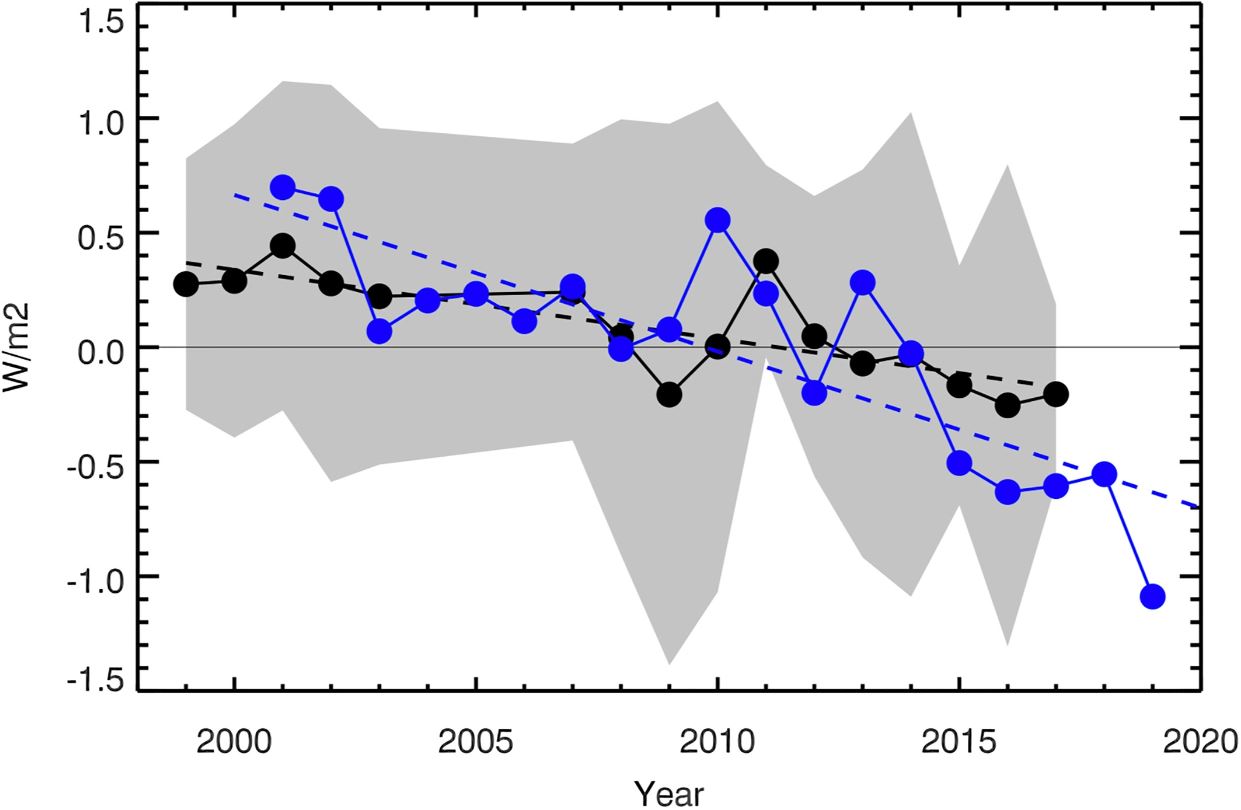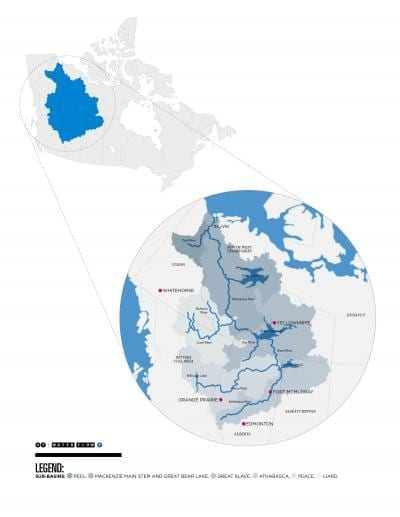
Earthshine annual mean albedo 1998–2017 expressed as watts per square meter (W/m2). The CERES annual albedo 2001–2019, also expressed in , are shown in blue. A best fit line to the CERES data (2001–2019) is shown with a blue dashed line. Average error bars for CERES measurements are of the order of 0.2 W/m2.
Credit: Goode et al. (2021), Geophysical Research Letters
Warming ocean waters have caused a drop in the brightness of the Earth, according to a new study.
Researchers used decades of measurements of earthshine — the light reflected from Earth that illuminates the surface of the Moon — as well as satellite measurements to find that there has been a significant drop in Earth’s reflectance, or albedo, over the past two decades.
The Earth is now reflecting about half a watt less light per square meter than it was 20 years ago, with most of the drop occurring in the last three years of earthshine data, according to the new study in the AGU journal Geophysical Research Letters, which publishes high-impact, short-format reports with immediate implications spanning all Earth and space sciences.
That’s the equivalent of 0.5% decrease in the Earth’s reflectance. Earth reflects about 30% of the sunlight that shines on it.
“The albedo drop was such a surprise to us when we analyzed the last three years of data after 17 years of nearly flat albedo,” said Philip Goode, a researcher at New Jersey Institute of Technology and the lead author of the new study, referring to the earthshine data from 1998 to 2017 gathered by the Big Bear Solar Observatory in Southern California. When the latest data were added to the previous years, the dimming trend became clear.
Two things affect the net sunlight reaching the Earth: the Sun’s brightness and the planet’s reflectivity. The changes in Earth’s albedo observed by the researchers did not correlate with periodic changes in the Sun’s brightness, so that means changes in Earth’s reflectiveness are caused by something on the Earth.
Specifically, there has been a reduction of bright, reflective low-lying clouds over the eastern Pacific Ocean in the most recent years, according to satellite measurements made as part of NASA’s Clouds and the Earth’s Radiant Energy System (CERES) project.
That’s the same area, off the west coasts of North and South America, where increases in sea surface temperatures have been recorded because of the reversal of a climatic condition called the Pacific Decadal Oscillation, with likely connections to global climate change.
The dimming of the Earth can also be seen in terms of how much more solar energy is being captured by Earth’s climate system. Once this significant additional solar energy is in Earth’s atmosphere and oceans, it may contribute to global warming, as the extra sunlight is of the same magnitude as the total anthropogenic climate forcing over the last two decades.
“It’s actually quite concerning,” said Edward Schwieterman, a planetary scientist at the University of California at Riverside who was not involved in the new study. For some time, many scientists had hoped that a warmer Earth might lead to more clouds and higher albedo, which would then help to moderate warming and balance the climate system, he said. “But this shows the opposite is true.”
Original Article: EARTH IS DIMMING DUE TO CLIMATE CHANGE
More from: New Jersey Institute of Technology | University of La Laguna | New York University
The Latest Updates from Bing News & Google News
Go deeper with Bing News on:
Earth’s reflectance
- Lunar Link: Scientists Believe They've Identified Origin of Potential Extra Moon Orbiting Earthon April 25, 2024 at 12:02 pm
An asteroid zipping through space in sync with Earth's orbit may be a stray piece of the moon, scientists say. Now, they believe they've pinpointed the exact lunar crater it originated from. Published ...
- Earth may have second Moon in futureon April 23, 2024 at 7:16 am
A speedy asteroid orbiting in time with Earth is likely to be a wayward chunk of the Moon.As of now, scientists speculate that they know exactly about which lunar crater it came from.Published ...
- An extra moon may be orbiting Earth — and scientists think they know exactly where it came fromon April 23, 2024 at 7:15 am
The near-Earth asteroid Kamo'oalewa, which orbits alongside our planet as a 'minimoon,' may have originated from Giordano Bruno crater on the far side of the moon, new research suggests.
- NASA video shows stunning scene from extremely volcanic world Ioon April 22, 2024 at 10:15 am
NASA's Juno spacecraft recently swooped by the most powerful volcano in our solar system, on the most volcanic world known to exist.
- Xtra Energy Corp. Presents a Google Earth Tour of High-Resolution Satellite Imagery Results for its American Antimony Project Near Eastgate, Nevadaon April 18, 2024 at 6:25 am
AUSTIN, TX / ACCESSWIRE / April 18, 2024 / (OTC PINK:XTPT) is excited to present a Google Earth tour of the recently disclosed results on the interpretation of high-resolution satellite images ...
Go deeper with Google Headlines on:
Earth’s reflectance
[google_news title=”” keyword=”Earth’s reflectance” num_posts=”5″ blurb_length=”0″ show_thumb=”left”]
Go deeper with Bing News on:
Albedo
- Hit anime OVERLORD arrives on mobile RPG Epic Sevenon April 19, 2024 at 12:00 pm
Smilegate and developer Super Creative’s hit mobile RPG Epic Seven is playing host to the characters from the hugely popular anime and manga OVERLORD in their latest collaboration event running until ...
- Researchers reveal sources of black carbon in southeastern Qinghai-Tibet plateauon April 19, 2024 at 10:11 am
Black carbon (BC) is the result of incomplete combustion of fossil fuels and biomass, with strong light absorption. It is second only to carbon dioxide as a climate-forcing factor for atmospheric ...
- Vangelis on how the natural, positive force of music got corruptedon April 17, 2024 at 12:14 am
In a rare interview, the singular creative force detailed his distaste for the music industry and explained his thinking on the science and power of his art ...
- Astrophysicists solve mystery of heart-shaped feature on the surface of Plutoon April 15, 2024 at 8:52 am
The mystery of how Pluto got a giant heart-shaped feature on its surface has finally been solved by an international team of astrophysicists led by the University of Bern and members of the National ...
- Could tree planting warm Earth? Science behind the albedo effecton March 31, 2024 at 11:29 am
But what if it's not always that simple? A new study by Clark University reveals a hidden factor, the albedo effect, that could turn a well-intended tree-planting project into a climate misstep.
Go deeper with Google Headlines on:
Albedo
[google_news title=”” keyword=”albedo” num_posts=”5″ blurb_length=”0″ show_thumb=”left”]










